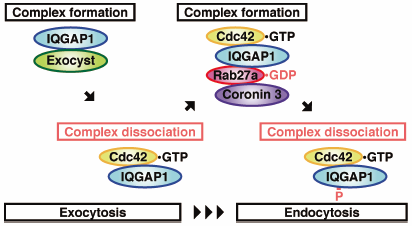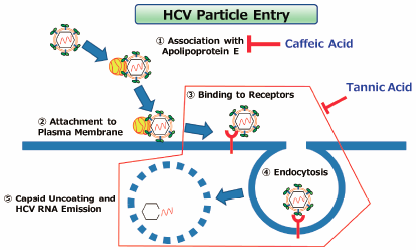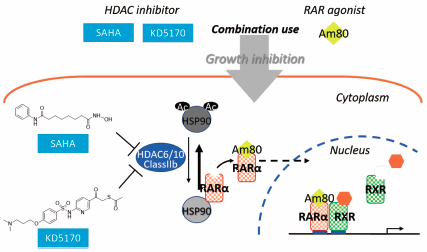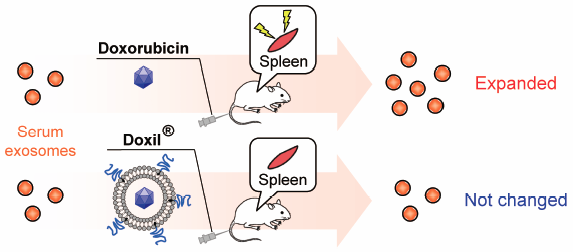-
編集者のコメント
Allergic contact dermatitis (ACD) is one of the most common skin diseases caused by hapten-modified proteins. The article demonstrated that metformin inhibited inflammatory responses in macrophages. Furthermore, metformin also enhanced autophagic flux, inhibited the phosphorylation of AKT/mTOR, MAPKs related protein levels and the level of miR-221 in macrophages. Besides, metformin attenuated 2,4-dinitrofluorobenzene (DNFB) -induced ACD partly through the inhibition of macrophage activation and the induction of autophagic flux. Taken together, the results indicated that metformin ameliorates ACD through enhanced autophagic flux to inhibit macrophage activation and provides a potential contribution to ACD treatment.
-
編集者のコメント
Thrombin is a serine protease as a blood coagulation factor, but also has been implicated in the pathology of brain ischemia, stroke or neurogenerative diseases. In this study, Akaishi et al. have demonstrated that the synthetic curcumin derivative CNB-001 suppresses thrombin-induced NO production through the inhibition of ERK and p38 MAPK pathways in microglia. In contrast, the authors have previously reported that CNB-001 suppressed LPS-induced NO production through the inhibition of p38 MAPK, but not ERK. Therefore, additional studies on differences in signaling cascades by which thrombin and LPS promote ERK phosphorylation will help to identify the direct molecular target of CNB-001.
-
編集者のコメント
Hypersensitive reaction to pathogenic attacks in plants triggers the expression of numerous plant genes encoding defense proteins. Pathogenesis-related (PR) proteins play an important role in inducing strong self-defense systems by getting accumulated in intercellular parts and vacuoles. Joo et al. cloned a PR protein gene from Oenanthe javanica (OJPR), which included PR-10 allergen without putative IgE binding residues, comprising 154-amino acids with a molecular mass of 16 kDa. The results of this study suggested that the newly identified and expressed OJPR may possess the biological activity and play a role in modulating host defense responses via Toll-like receptor signal cascades together with anti-viral activities in immune cells.
-
42 巻 (2019) 11 号 p. 1926-1935Development of a Novel Intraocular-Pressure-Lowering Therapy Targeting ATX もっと読む編集者のコメント
Elevated intraocular pressure (IOP) is the major cause of glaucoma, which is the second leading cause of blindness. To develop new IOP-lowering treatments, the article by Nagano et al. generated a novel ATX inhibitor as an ophthalmic drug by high-throughput screening, followed by inhibitor optimization. Administration of the optimized ATX inhibitor (Aiprenon) reduced IOP in laser-treated mice exhibiting elevated IOP and higher level of ATX activity in AH and normal mice in vivo. The stimulation of ATX induced outflow resistance in the trabecular pathway; however, administration of Aiprenon recovered the outflow resistance in vitro.
-
編集者のコメント
Recent clinical studies indicate that sodium glucose cotransporter 2 (SGLT2) inhibitors exhibit a renoprotective effect. However, the mechanism underlying this effect has not been fully elucidated. The article by Takakura and Takasu found that single intravenous injection of ipragliflozin, a selective SGLT2 inhibitor, at a dose that increased glucose excretion reduced creatinine clearance without affecting systemic blood pressure in type 2 diabetic mellitus STD-fatty rats. These results suggest that SGLT2 inhibition directly reduces whole-kidney glomerular filtration rate, most likely due to a reduction in intraglomerular pressure, by altering local renal hemodynamics. This effect might explain the renoprotective effects demonstrated in clinical studies, at least partly.
-
編集者のコメント
Glucose-stimulated insulin secretion is controlled by both exocytosis and endocytosis in pancreatic β-cells. Although endocytosis is a fundamental step to maintain cellular responses to the secretagogue, the molecular mechanism of endocytosis remains poorly defined. Kimura et al. have demonstrated the regulatory mechanisms of the IQGAP1/GDP-bound Rab27a endocytic machinery. PKCε, which was activated by glucose stimulation, phosphorylated IQGAP1 on Ser-1443, thereby promoting the dissociation of the IQGAP1/GDP-bound Rab27a complex in pancreatic β-cells. Insulin secretion is controlled by stage-specific complex formation and the dissociation of IQGAP1 from its specific binding partners.
-
編集者のコメント
Reconstituted discoidal high-density lipoprotein particles are called lipid nanodisks, which can be developed for biocompatible delivery vehicles. The article by Tanaka et al. designed lipid nanodisks using a peptide (LpA peptide) with the LDL receptor-binding region of apolipoprotein E (apoE). Discoidal LpA nanodisks of approximately 10 nm in size were successfully prepared. In addition, the uptake of LpA nanodisks was higher than that of apoE nanodisks especially under the condition where the expression of LDL receptor was increased (LPDS) compared with the normal condition (FBS). Thus, LpA nanodisks are potential biocompatible delivery vehicles targeting LDL receptors.
-
42 巻 (2019) 7 号 p. 1140-1145Myalgic Encephalomyelitis/Chronic Fatigue Syndrome Induced by Repeated Forced Swimming in Mice もっと読む編集者のコメント
Myalgic encephalomyelitis/chronic fatigue syndrome (ME/CFS) has few beneficial treatments for patients. Recently, the involvement of pyruvate dehydrogenase (PDH) in ME/CFS has been reported. However, it is little known whether PDH could be a therapeutic target of ME/CFS. In this paper, Ohba et al. established ME/CFS model in mice and investigated the involvement of PDH. In an ME/CFS group, PDH activity was decreased in the mitochondrial fraction of the gastrocnemius muscle. Sodium dichloroacetate (DCA), which is a PDH activator, recovered fatigue-like behavior in ME/CFS group. These findings indicate that PDH might be an important therapeutic target for treatment of ME/CFS.
-
42 巻 (2019) 6 号 p. 944-953Selective Protein Expression Changes of Leukocyte-Migration-Associated Cluster of Differentiation Antigens at the Blood–Brain Barrier in a Lipopolysaccharide-Induced Systemic Inflammation Mouse Model without Alteration of Transporters, Receptors or Tight Junction-Related Protein もっと読む編集者のコメント
Leukocyte migration across the blood-brain barrier (BBB) is a key step in the progression of brain dysfunction in systemic inflammation. The key regulatory molecules at the BBB involved in leucocyte-endothelial interaction would be promising druggable targets. Sato et al. have established the LC-MS/MS-based comprehensive absolute protein quantification system for the cluster of differentiation (CD) antigens and identified the key molecules at mouse BBB in lipopolysaccharide (LPS)-induced systemic inflammation based on their absolute protein expressions. Their findings should be helpful in the development of BBB-targeting drugs to block leukocyte migration associated with central nervous system disorders.
-
42 巻 (2019) 5 号 p. 770-777Inhibition Mechanisms of Hepatitis C Virus Infection by Caffeic Acid and Tannic Acid もっと読む編集者のコメント
The article by Shirasago et al demonstrated that the coffee-related compounds caffeic acid and tannic acid act on hepatitis C virus (HCV) particles and abrogate their infectivity. Particularly, the authors demonstrated that caffeic acid significantly reduced cellular attachment of HCV particles and their interaction with host apolipoprotein E, which is essential for HCV infectivity. Intake of coffee or the coffee-related compounds caffeic acid and tannic acid, which are inexpensive and easy to supply, might lead to prevention of HCV infection and slower disease progression after HCV infection.
-
42 巻 (2019) 3 号 p. 448-452Class IIb HDAC Inhibition Enhances the Inhibitory Effect of Am80, a Synthetic Retinoid, in Prostate Cancer もっと読む編集者のコメント
The growth-inhibitory effects of Am80 (tamibarotene), a specific retinoic acid receptor (RAR) α/β agonist, in combination with a histone deacetylase (HDAC) inhibitor, suberoylanilide hydroxamic acid (SAHA) on androgen receptor positive or negative prostate cancer cell lines were investigated. Ishigami-Yuasa et al. found that the combination therapy of Am80 and SAHA showed an enhanced growth-inhibitory effect on LNCaP cells. Studies with various HDAC isotype-selective inhibitors indicated that the Class IIb HDACs, especially HDAC6, had significant roles in the enhanced effect of the combination. Thus, dual targeting of Class IIb HDAC and RARα would be useful therapeutic strategy for prostate cancer.
-
42 巻 (2019) 2 号 p. 273-279Hepatic and Intrahepatic Targeting of Hydrogen Sulfide Prodrug by Bioconjugation もっと読む編集者のコメント
The delivery of hydrogen sulfide (H2S) to liver is expected for the treatment of hepatic diseases. K. Sakai et al. developed two types of sulfo-albumins, macromolecular H2S prodrugs, for hepatic and intrahepatic targeting of H2S. Sulfide groups (source of H2S) were covalently bound to succinylated (Suc) and galactosylated (Gal) bovine serum albumin (BSA) for targeted delivery of H2S to hepatic nonparenchymal cells and parenchymal cells, respectively. Their results demonstrated targeted delivery of H2S prodrug to a specific type of liver cells using the chemical modification of targeting ligands.
-
編集者のコメント
CXC chemokine ligand (CXCL) 10 is a chemokine that binds to CXCR3 expressed on natural killer (NK) cells and cytotoxic T lymphocytes. In this paper, Kikuchi et al. showed that forced expression of CXCL10 in murine colon carcinoma CT26 cells prevents their in vivo proliferation and liver metastasis by recruiting NK cells, suggesting that forced expression of CXCL10 in the colon tumors by gene delivery should lead to a favorable clinical outcome.
-
41 巻 (2018) 12 号 p. 1853-1858Skin Sensitization to Fluorescein Isothiocyanate Is Enhanced by Butyl Paraben in a Mouse Model もっと読む編集者のコメント
Fluorescein isothiocyanate (FITC)-induced contact hypersensitivity is a mouse model of skin allergy to chemicals. In this model, chemicals such as phthalate esters are known to enhance skin sensitization to FITC. The article by Matsuoka et al. demonstrated that butyl paraben (BP), a common preservative, enhances skin sensitization as revealed by ear-swelling response to FITC. Mechanistically, BP facilitates dendritic cell trafficking from skin to lymph nodes, and enhances cytokine production from lymph node cells. Their results provide direct in vivo evidence that BP, like phthalate esters, enhances sensitization to other chemicals.
-
41 巻 (2018) 11 号 p. 1716-1721Analysis of Glycoforms and Amino Acids in Infliximab and a Biosimilar Product Using New Method with LC/TOF-MS もっと読む編集者のコメント
How can you know the structural difference between biosimilar and reference product? The structure of biosimilar products is not the same as their original product because of post-translational modifications. In the article by Tsuda et al., a valuable method with a papain digestion and LC/TOF-MS analysis was established. Their new method can analyze not only carbohydrate chains but also amino acids of bio-medicines including biosimilar antibodies. This technology will provide a useful strategy to evaluate bio-medicines including biosimilar antibodies.
-
41 巻 (2018) 10 号 p. 1567-1573Characteristics of Bone Strength and Metabolism in Type 2 Diabetic Model Nagoya Shibata Yasuda Mice もっと読む編集者のコメント
Type 2 diabetes mellitus (T2DM) animal models are often used in basic research on diabetic osteoporosis. The article by Tanaka et al. elucidated hyperglycemia contributed to a decrease in bone metabolism turnover in the T2DM animal model NSY mice, resulting in a thinner and shorter femur, lower cortical and trabecular area, and lower bone mass. Their results suggest that these effects contribute to the deteriorated bone strength of the femur in NSY mice, and the NSY mouse could serve as an appropriate T2DM animal model for examining the specific effect of hyperglycemia on bone integrity, using the ICR mouse as a control.
-
41 巻 (2018) 9 号 p. 1456-1462Effects of Supplementary Seleno-L-methionine on Atopic Dermatitis-Like Skin Lesions in Mice もっと読む編集者のコメント
Seleno-L-methionine (SeMet) is a major form of selenium compounds in foods. The article by Arakawa et al. demonstrated that ear thickness was increased by repeated application of 2,4,6-trinitrochlorobenzene (TNCB) to the ear, and SeMet significantly suppressed ear thickness in mice. SeMet inhibited epidermal hyperplasia and dense infiltration of inflammatory cells. Serum total immunoglobulin (Ig) E levels were suppressed by SeMet. Interleukin (IL) 4 expression in the ear and superficial parotid lymph node was inhibited by SeMet. These results demonstrated that SeMet suppresses atopic dermatitis-like skin lesions and inhibits the expression of total IgE and IL-4.
-
41 巻 (2018) 7 号 p. 1078-1083Doxorubicin Expands in Vivo Secretion of Circulating Exosome in Mice もっと読む編集者のコメント
Exosomes are extracellular vesicles released by various types of cells, including immune cells and cancer cells. The article by Emam et al evaluated in vivo secretion of exosomes following intravenous injection of free doxorubicin (DXR) or liposomal DXR (Doxil®) was evaluated using normal mice. Free DXR treatment markedly increased the serum exosome level, while Doxil® treatment did not change. Interestingly, splenectomy significantly suppressed the exosomal secretions induced by free DXR treatment. Their results suggest that conventional anticancer agents induce the secretion of exosomes via stimulating immune cells of the spleen, and might contribute to the antitumor effect of chemotherapeutic agents.
-
編集者のコメント
The article by Ohsaki et al. proposed a novel mechanism of cytokine production in γ-irradiated cells. γ-Ray irradiation induced sustained IL-6 production in HaCaT epidermal cells from 33 h after irradiation. Extracellular ATP-induced activation of P2Y11 receptor was involved in the production of IL-6. At the downstream of P2Y11 receptor activation, the p38 MAPK and NF-kB signaling was involved in IL-6 production. The protein level of G9a, which inhibits IL-6 production, was decreased after g-irradiation. These findings should be helpful to understand the pathogenesis of radiation-induced inflammation, as well as the potential side effects of therapeutic irradiation.
-
41 巻 (2018) 5 号 p. 761-769Protective Effect of Ipragliflozin on Pancreatic Islet Cells in Obese Type 2 Diabetic db/db Mice もっと読む編集者のコメント
Ipragliflozin is a selective sodium glucose cotransporter 2 inhibitor that increases urinary glucose excretion, and subsequently improves glucolipotoxicity. The article by Takasu et al. demonstrated that the treatment with ipragliflozin decreased pancreatic cells positive for 4-hydroxy-2-nonenal (4HNE), an oxidative stress marker, in obese type 2 diabetes mellitus (DM) db/db mice. Histopathological examination of pancreatic islet cells revealed strong insulin staining, whereas reduced glucagon staining, accordingly pancreatic insulin content tended to be higher in the ipragliflozin 10 mg/kg-treated group compared with the DM-control group. It was demonstrated that ipragliflozin has a protective effect on the pancreas by reducing oxidative stress.



















